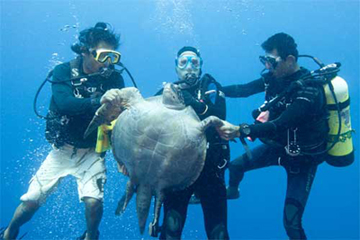Tax-Deductible Cocos Dive Trips, and Others Around the WorldContents of this Issue: Sea Hunter, Cocos Island, Costa Rica Tax-Deductible Cocos Dive Trips, and Others Around the World Hollis Recalls Some Explorer Rebreather Models Baja California, Fiji, Montserrat Dengue Fever in Fiji: Should Divers Worry? The Decline of Dive Training: Part II Sandals, the Certification King? Legal Charges Scuttle Galapagos Liveaboards Gas-Integrated Computer Transmitters To Sharks, Divers Plus Lionfish Equals Food The Fastest-Growing Segment of Diving? Where the Freediving Instructors Are Bret Gilliam Asks: Can You Get Bent From Freediving? A New App for Coral Sea Diving Editorial Office: Ben Davison Publisher and Editor Undercurrent 3020 Bridgeway, Suite 102 Sausalito, CA 94965 from the April, 2014 issue of Undercurrent
STRP and PRETOMA have been tagging and tracking turtles for years in an attempt to map their migration routes. Biologists have placed acoustic receivers at six locations around Cocos to record the presence of tagged animals. The final task for divers during the tagging trips is to recover the receivers, download data, replace the batteries and reinstall the receivers in their underwater locations. There are additional receivers near the Galapagos and the Central American mainland to track migration routes so the turtles can be protected. -- S.L. * * * * * STRP has more turtle-tagging trips at Cocos scheduled for this year and next. There's room for one male diver on its next trip, May 26 to June 5; everyone else can book for December 9-19, and then in February or July of 2015 ( http://seaturtles.org/article.php?id=1703 ). The price is $6,250 plus airfare. We did a travel feature last November on one diver's trip with the New England Aquarium aboard the RV Coral Reef II to tag and collect fish in the Bahamas. You can do the same trip October 18-28 ( www.neaq.org/education_and_activities/programs_and_classes/members-only_programs/bahamas_collecting_trips.php ). The Reef Environmental Education Foundation (REEF) regularly hosts weeklong "field survey" trips that teach divers how to identify fish and collect data for REEF scientists. This year's trips are clustered in the Caribbean, from Honduras's Bay Islands June 21-28 to Nevis December 6-13 -- but there is a cold-water option at British Columbia's Hornby Island September 14-18 ( www.reef.org/trips ). Earthwatch's goal is to get more people helping with scientific field research and education, so it sponsors expeditions for people with no special skills to become "research assistants" and work alongside scientific pros. They run many expeditions, from swimming with sea turtles in the Bahamas to monitoring endangered manta rays at Australia's Lady Elliott Island. ( www.earthwatch.org/expedition ). If you have the time (and money) to go halfway around the globe for a good cause, Blue Ventures, a Britishbased marine conservation nonprofit, is always looking for divers to spend six weeks helping its scientists chart and study the remote southwestern reefs of Madagascar. Rustic, most likely, but one-of-a-kind volunteering experience, absolutely. ( www.blueventures.org ) To get a tax deduction, any volunteer trip must be run by a nonprofit with a 501(c)(3) tax-exempt status (because Blue Ventures is based in the U.K., American divers would be out of luck). The IRS "insists" that the volunteer work must have no "significant" element of personal pleasure or recreation (but, rest assured, there will be no tax man there to look over your shoulder when you order a cold one). This means you'll need to volunteer about eight hours a day, five days a week to qualify to deduct the airfare or other travel expenses. If you tack on a couple extra days to visit the hotspots, the regulations do not allow you to deduct the airfare. However, you will still be able to get a tax break for the program fee, meals and supplies directly related to your time spent volunteering. |

I want to get all the stories! Tell me how I can become an Undercurrent Online Member and get online access to all the articles of Undercurrent as well as thousands of first hand reports on dive operations world-wide
| Home | Online Members Area | My Account |
Login
|
Join
|
| Travel Index |
Dive Resort & Liveaboard Reviews
|
Featured Reports
|
Recent
Issues
|
Back Issues
|
|
Dive Gear
Index
|
Health/Safety Index
|
Environment & Misc.
Index
|
Seasonal Planner
|
Blogs
|
Free Articles
|
Book Picks
|
News
|
|
Special Offers
|
RSS
|
FAQ
|
About Us
|
Contact Us
|
Links
|
3020 Bridgeway, Ste 102, Sausalito, Ca 94965
All rights reserved.

 My two previous trips to Cocos Island were on the MV Argo,
another of the Undersea Hunter fleet, to assist biologists from
the U.S.-based Sea Turtle Restoration Network ( STRN;
My two previous trips to Cocos Island were on the MV Argo,
another of the Undersea Hunter fleet, to assist biologists from
the U.S.-based Sea Turtle Restoration Network ( STRN; 